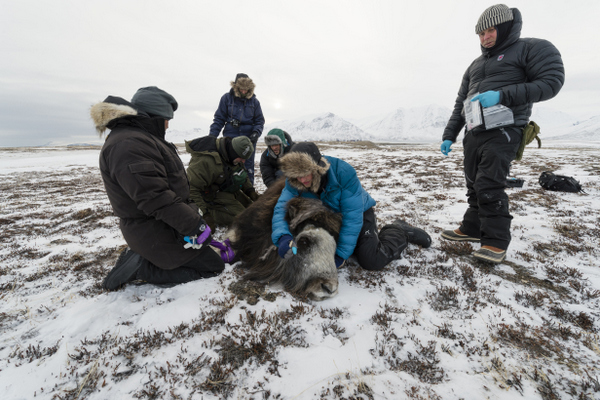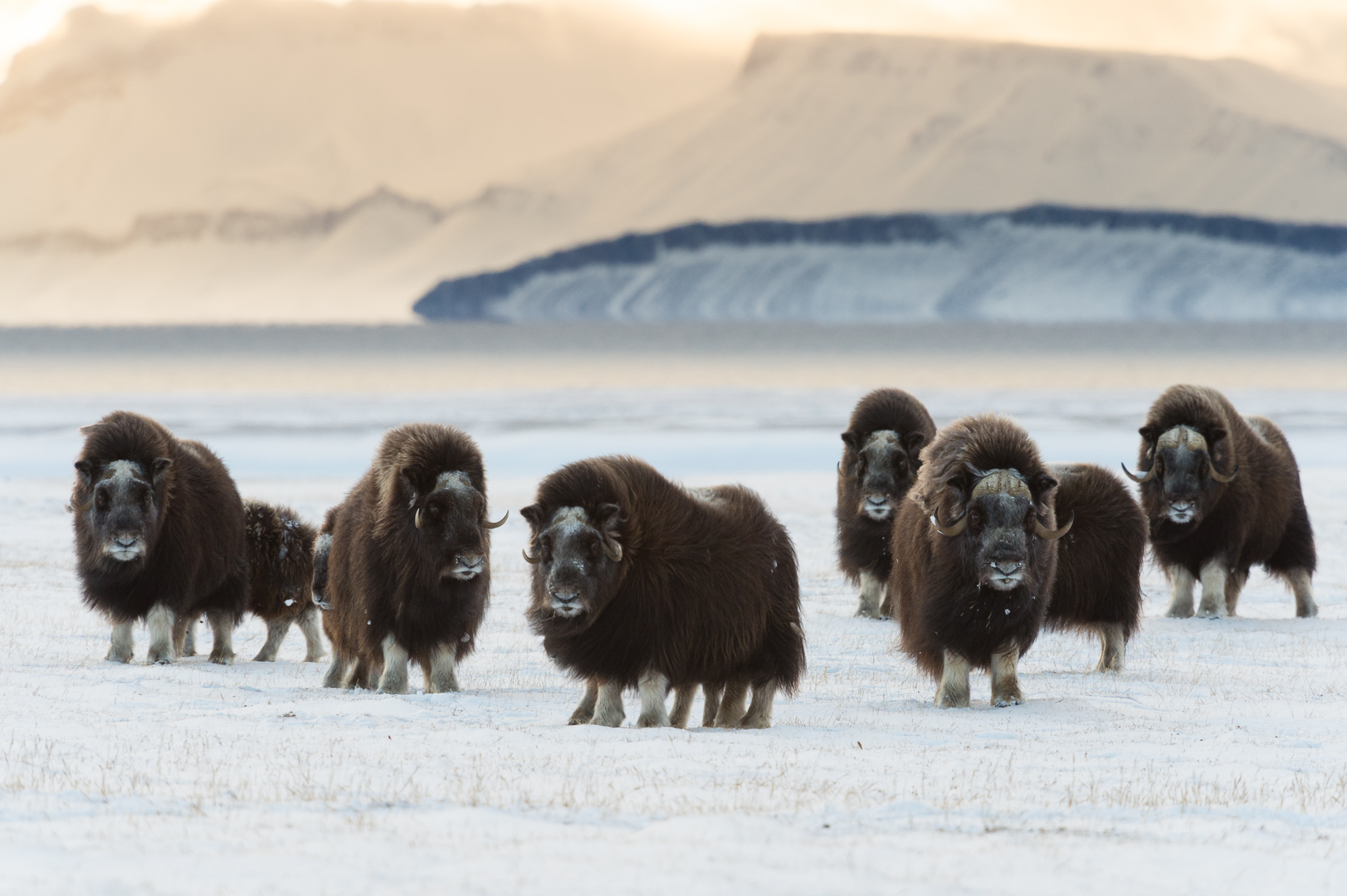For the first time satellites follow musk oxen in Northeast Greenland
You may ask yourself why a musk ox first crosses a wide frozen fjord and continues up a frozen high-altitude glacier where it wanders for several days over the Clavering Island in Northeast Greenland. But it does. And this is quite true because last year fourteen musk oxen had satellite transmitters fitted around their necks and researchers in Denmark now receive information every hour on the whereabouts of the oxen in the world’s largest national park.


A muscular musk ox with sharply pointed horns, weighing between 200 and 300 kilos, is not to joke with. Six fully grown men know what they have to do when they stand face-to-face with the wandering Arctic woolen blanket with the large skull.
Researchers from Aarhus University, together with a team from Copenhagen Zoo, travelled to Zackenberg Research Station in Northeast Greenland in order to fit satellite transmitters on a number of musk oxen.
It is October and bitterly cold. But each man knows what to do when veterinarian Carsten Grøndahl from Copenhagen Zoo puts the rifle to his cheek and sends the arrow tipped with sedative towards the selected cow.
Carsten Grøndahl has tried this before. He is used to sedating the large animals in the zoo when they need to be examined by a veterinary surgeon. He knows exactly the quantity of sedative needed to make it calm. The dose must not be too high to avoid risk of dying.
The scientists are working quickly. They take blood samples from the sedated musk ox, photographs of its teeth to assess its age and finally fit a solid collar around its neck with a small box containing a GPS navigator and a small satellite phone.
Then Carsten Grøndahl gives the musk ox an injection to reverse the effect of the sedative, and all men let go of the large animal at the same time. At first it is somewhat dizzy and uncertain on its feet, but quickly it joins the rest of the herd that has followed the incidence at a distance without showing much interest.
Sparse vegetation
The musk ox feeds on the sparse vegetation that the rough and inhospitable landscape offers. The plants seldom grow more than a few cm high. During winter temperatures drop to minus 40 oC. It is pitch dark and almost the entire landscape is covered by snow and ice. A rough habitat for the large animal that is shielded by a matted blanket of warm, insulating wool.
Particularly in the autumn numerous musk oxen are observed on the tundra at the Zackenberg Research Station. The researchers have counted 412 oxen within a 30 km2 area around the station.
But no one really knows where the animals go when winter falls on. How far they migrate, which areas they prefer and how they will cope with the climate change. The altered climate will lead to more precipitation in the form of snow and longer periods of alternating thaw and frost will challenge animals that scrape through snow and ice in order to find food.
Musk ox online
The researchers fitted transmitters around the necks of fourteen different cows. Cows were chosen because they often wander in herds and in this way a whole group of animals can be followed. Bulls often roam around alone. Six bulls were marked with yellow tags in their right ear, permitting the researchers to recognize them if they spot them through binoculars or find their dead carcass.
And now data pour in from the many transmitters. Every hour a message is sent to Denmark via satellite.
Biologist Lars Holst Hansen participated in the marking of the musk oxen and stays at the Zackenberg Research Station during most of the summer half-year. He has been working with the large amount of data and has made a small video presentation showing the wandering of the fourteen cows since the transmitters were fitted. When plotting the position of the animals on Google Earth, you will have a small movie that visually pinpoints the area seen by the cows during their wandering.
“We can see that the cows do not always move in the same herd. Sometimes they join one herd and later another. We can also see which areas the oxen prefer and where they stay for longer periods of time,” Lars Holst Hansen says.
Moreover, the researchers can track the animals on their long expeditions to remote areas such as the two oxen crossing the frozen fjord to climb onto Clavering Island. One of them crossed the 9 km wide mouth of the fjord in only three hours. And after crossing the fjord one of them wandered to the top of the island via a bare glacier and down to the other side of the island. A lone wandering in ice for two days.
”We can only assume that they have an experience telling them the grass is greener on the other side. That they have been there before or that another musk ox has shown them the way,” Lars Holst Hansen speculates.
A warmer Arctic
Two of the marked oxen perished in the harsh winter. This was also revealed by the transmitters that emit from the same point all the time. One died on 12 March and the other in late May.
”We have found one the oxen and retrieved the transmitter. The ox was all skin and bone and samples from the bone marrow showed that it had drained its last resources,” Lars Holst Hansen says.
The investigation of musk ox migration patterns and movements is part of a large multi-faceted research project based at Zackenberg Research Station. The overall aim is to investigate how climate-induced changes alter arctic ecosystems.
“There is no doubt that extreme winters with heavy precipitation are hard on the musk oxen,” Lars Holst Hansen says.
In the Arctic the precipitation comes as snow, and the researchers expect more snow in Northeast Greenland in a warming climate. At the same time the number of warm days will increase and indications are that when days are warm the surface of the snow will thaw and flow through the snow masses as water. When the snow refreezes, an ice shell will form that is very difficult for the oxen to scrape trough
The satellite transmitters now provide the researchers with invaluable knowledge of the movements of the musk oxen and the areas that they prefer. Combined with numerous other data, for instance on snow cover, the researchers can assess the role of the musk ox in the arctic ecosystem of the future.
In 1962 and 1965 musk oxen were moved from Northeast Greenland to Søndre Strømfjord on the Greenland west coast which has a warmer climate and a more lush vegetation. Since then, the musk ox has developed a large population and spread to large areas.
Further information:
Academic employee Lars Holst Hansen, Arctic Research Centre, Aarhus University. Biobasis.ZacBasis@skyfile.com, tel.: 00881641464327
Senior scientist Niels Martin Schmidt, Arctic Research Centre, Aarhus University. nms@dmu.dk, tel. +45 87158683/ mobile +45 41915664
